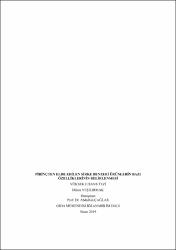Pirinçten elde edilen sirke benzeri ürünlerin bazı özelliklerinin belirlenmesi
Abstract
Bu araştırma, besin değeri yüksek olan pirincin kavuzundan ayrıldıktan sonra işlem görmemiş hali olan esmer pirinç, tıraşlama işlemiyle elde edilen beyaz pirinç ve tıraş işleminde çıkan tıraş artıklarından olmak üzere üç farklı formdaki yapılarından sirke üretiminin araştırılması ve sonucunda elde edilen sirke benzeri ürünlerin kalite özelliklerinin incelenmesi üzerine yapılan bir çalışmadır. Dünya’da sirkenin sağlık ve kullanım amaçlarına göre birçok yöntem ile çeşitli sirke üretimleri yapılmaktadır. Sirkenin kimyasal bileşimini incelendiğinde tat ve uçucu bileşenler, alkoller, amino asitler, organik asitler, fenolik bileşenler oluşturmaktadır. Sirkenin oluşumunda kullanılan hammadde bu içerikleri etkileyen önemli faktörlerdendir. Araştırmamızda kullanılan piriç berrak renkte, danesi orta irilikteolup Çorum ili Osmancık Belediyesinden temin edilmiştir. Pirincin kavuzundan ayrıldıktan sonra işlem görmemiş hali olan esmer pirinç, tıraşlama işlemiyle elde edilen beyaz pirinç ve tıraş işleminde çıkan tıraş artıklarından olmak üzere üç farklı formda sirke oluşum sürecinde pH, toplam asitlik (titrasyon asitliği), alkol tayini analizleri yapılmıştır. Hammadde de renk, kül, kuru madde, pH, brix,toplam asitlik, mineral madde, antioksidan kapasite tayini(DPPH metodu) ve toplam fenolik madde(Folin-Ciocalteu Yöntemi) tayini ve sirke oluşumunda ise depolamanın sirke bileşenleri üzerine etkisini görebilmek için otuzuncu ve altmışıncı gün yapılan analizler; antioksidan kapasite tayini(DPPH metodu), toplam fenolik madde(Folin-Ciocalteu Yöntemi), renk, kül, pH, toplam asitlik (titrasyon asitliği), iletkenlik (kondaktivite), toplam kuru madde, yoğunluk,suda çözünür kuru madde (brix), mineral madde analizi ve duyusal analizidir. Hammaddelerden açık ve kapalı yöntem olmak üzere açık yöntemle üretilen tıraşlanmış pirinç (beyaz) (BAS), kapalı yöntemle üretilen tıraşlanmış pirinç (beyaz) (BKS), açık yöntemle üretilen tıraşlanmamış pirinç (esmer) (EAS), kapalı yöntemle üretilen tıraşlanmamış pirinç (esmer) (EKS),açık yöntemle üretilen pirinç tıraşı(TAS), kapalı yöntemle üretilen pirinç tıraşı (TKS), olmak üzere 6 numune olarak sirke üretimi paralelli çalışılmıştır. 21 gün boyunca hergün karıştırmak suretiyle sirke kavanozları ince bir tülbentle kapatılmıştır.21. günün sonunda tıraşlanmış pirinç, tıraşlanmamış pirinç ve pirinç tıraşı sirkelerinin her birinden bir adet olmak üzere üç şişe numunenin ağızları tamamen hava almayacak şekilde kapatılmıştır. Diğer kalan üç şişe sirke numune ise kontrollü hava akımı sağlanması amacıyla fren sistemi olan kapaklara hortum takılarak kapatılmıştır. Hortumun diğer açık ucu boş cam şişe içerisine konulmuştur. In this research, the quality characteristics of the vinegar products obtained after shaving of the shaving process in the form of unprocessed brown rice, white rice obtained by shaving process and the production of three different vinegar after the separation of the rice with high nutritional value is made. According to the health and usage purposes of vinegar in the world, various vinegar products are produced. When the chemical composition of the circus is examined, taste and volatile components, alcohols, amino acids, organic acids and phenolic compounds are formed. Raw material used in the formation of the circus is one of the important factors affecting this content. The rice used in our study is of clear color and its grain is of medium size and it is obtained from Osmancık Municipality of Çorum province. After separation of rice from rice, untreated brunette rice, white rice obtained by trimming process and shaving residues in shaving process, pH, total acidity (titration acidity) and alcohol determination analysis were performed in three different forms of vinegar formation process. Raw material, color, ash, dry matter, Ph brix, total acidity, mineral matter, antioxidant capacity determination (DPPH method) and the total phenolic substance (Folin-Ciocalteu Method) determination and vinegar in the formation of the effect on the vinegar components to see the thirty and analysis on the sixtieth day; Determination of antioxidant capacity (DPPH method), total phenolic substance (Folin-Ciocalteu Method), color, ash, pH, total acidity (titration acidity), conductivity (total conductivity), total dry matter, density, water soluble dry substance (brix), mineral matter analysis and sensory analysis. Shaved rice (white) (BAS), which is produced by using open method from raw materials, with open method, shaved rice (white) produced by closed method (BKS), unshaved rice (brunette) (EAS), which is produced by open method, unshaved rice produced by closed method (brunette (EKS), brass shaving produced by open method (TAS), brass shaving produced by closed method (TKS), vinegar production parallel to six samples were studied. Vinegar jars were covered with a fine cheesecloth by mixing every day for 21 days. At the end of 21st day, three bottles of each one of each of the shaved rice, unshaved rice and rice shaving vinegar were closed in such a way that the mouths of the bottle were not completely aired. The remaining three bottles of vinegar samples were closed by attaching hoses to the braking system to ensure controlled air flow. The other open end of the hose is placed in the empty glass bottle.
Collections
- Yüksek Lisans Tezleri [890]



















